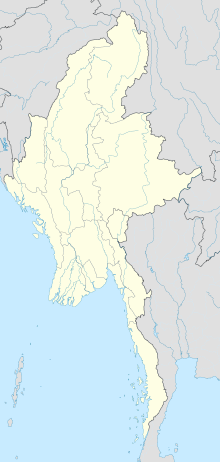Abeyadana temple is a 12th century Buddhist temple in Bagan, Myanmar. The temple complex has a large central temple, which has a rectangular plan.[1]
| Abeyadana temple | |
|---|---|
 Abeyadana temple in 2014 | |
| Religion | |
| Affiliation | Buddhism |
| Deity | Gautama Buddha |
| Patron | Abeyadana |
| Location | |
| Location | Bagan |
| Country | Myanmar |
| Geographic coordinates | 21°08′56″N 94°51′28″E / 21.148934°N 94.857674°E |
| Architecture | |
| Date established | c. 1094 CE |
History
editThe temple was built around 1090 CE, during the reign of king Kyanzittha.[2] A later ink inscription on the temple walls attributes its construction to Kyanzittha's queen Abeyadana.[3]
A local legend states that the temple was built at the place where Kyanzittha's queen Abeyadana waited for him.[4] According to G.H. Luce and Ba Shin, Abeyadana came from the Pattikera kingdom located in the eastern part of the Indian subcontinent (around present-day Comilla District in Bangladesh).[5] The murals in the temple are of east Indian (Pala) style, and were probably created by artists from eastern India.[2]
Paintings
editThe main idol of the temple is a brick image of Gautama Buddha.[1] On the west side of the Buddha image, a portrait-figure shows Abeydana praying to him. The north side of entrance hall features eight rows of Jataka frescos, with titles in Pali language and descriptions in Mon language (and often, the number of the Jataka tale).[3] A subsidiary panel shows the Buddha delivering his first sermon (the Dhammacakkappavattana Sutta). He is sitting cross-legged on a lotus throne, and his hands are in Dharmachakra mudra pose. He is surrounded by people paying obeisance to him: two celestial beings showering lotus flowers at the top, and two kings at the bottom.[6] There is also an image of the goddess Tara, who is shown with a curvy body, dressed in royal attire. On her left side, there is a padma lotus, and on her right side, there is a blue lotus. These flowers are said to signify her purity.[7]
Besides the orthodox Buddhist frescos, the temple walls also feature Tantric and Brahmanic elements.[3] The inner walls of the temple feature frescos of Hindu gods such as Brahma, Vishnu, Shiva and Indra.[1] In addition, there are paintings of deities specific to Burmese Buddhism, such as that of a cross-legged goddess.[8]
References
edit- ^ a b c Charles Higham 2014, p. 1.
- ^ a b Steven Kossak & Jane Casey Singer 1998, p. 59.
- ^ a b c G. H. Luce 1956, p. 293.
- ^ David Abram & Andrew Forbes 2013, p. 427.
- ^ Claudine Bautze Picron 2015, p. 2.
- ^ U Tin Lwin 1974, p. 242.
- ^ U Tin Lwin 1974, p. 247.
- ^ U Tin Lwin 1974, p. 248.
Bibliography
edit- Charles Higham (2014). Encyclopedia of Ancient Asian Civilizations. Infobase. ISBN 9781438109961.
- Claudine Bautze Picron (2015). "Textiles from Bengal in Pagan (Myanmar) from late eleventh century and onwards". In Mokammal H. Bhuiyan (ed.). Studies in South Asian Heritage: Essays in Memory of M Harunur Rashid (PDF). Bangla Academy. ISBN 9789840753833.
- David Abram; Andrew Forbes, eds. (2013). Insight Guides: Myanmar (Burma). Apa. ISBN 978-178005631-9.
- G. H. Luce (1956). "The 550 Jātakas in Old Burma". Artibus Asiae. 19 (3/4): 291–307. doi:10.2307/3248766. JSTOR 3248766.
- Steven Kossak; Jane Casey Singer (1998). Sacred Visions: Early Paintings from Central Tibet. Metropolitan Museum of Art. ISBN 978-087099862-1.
- U Tin Lwin (1974). "Old Burmese Painting". Oriens Extremus. 21 (2): 237–259. JSTOR 43383624.
